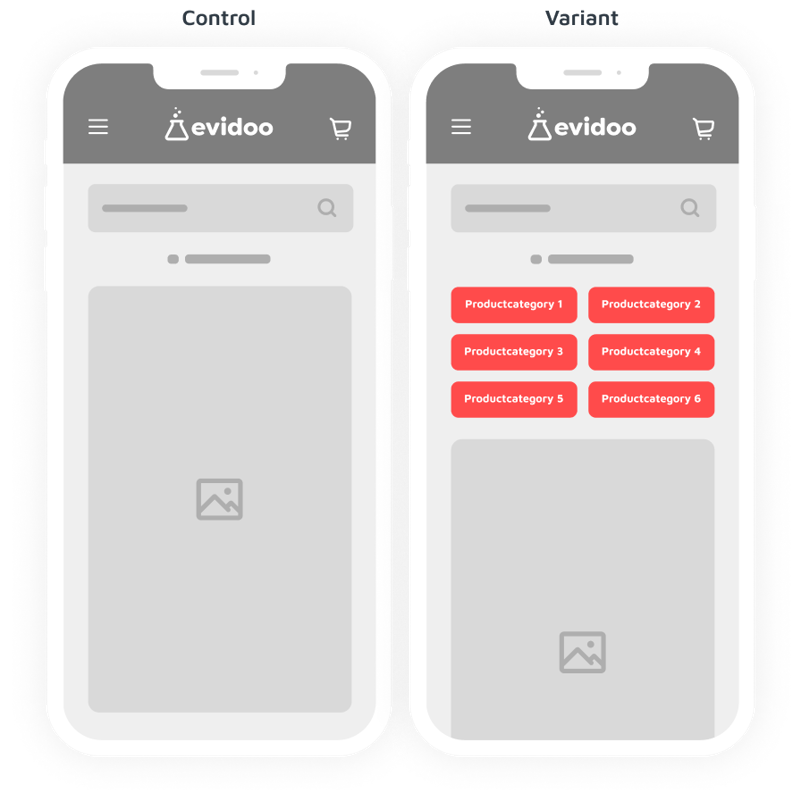52 | Add popular productcategories above the fold | Mobile

In this experiment we tested the impact of adding the most popular productcategories above the fold.
This hypothesis is grounded in the following psychological principles:
- Make it easier: Easier access to popular categories may reduce effort in navigation.
- Attract Attention: Prominent placement can draw users' focus to key content that is popular.
Based on this psychological background, we believe that adding popular productcategories above the fold will cause an increase in online transactions.
The experiments confirm that making popular productcategories immediately accessible on mobile homepages is a high-impact UX improvement.
Across all experiments, we consistently observed a notable increase in clicks to product overview pages and product detail pages. This indicates that placing popular categories above the fold doesn’t just impact transactions directly. It also significantly improves user navigation, engagement, and product discovery behavior.
Key learnings:
-
Product discovery improves when choices are made visible and relevant.
Users responded well to having shortcuts to familiar or top categories. This reduces friction and led them to browse more product overview and detail pages. This effect was consistent, even in industries with diverse user intent (e.g., furniture vs. baby & children). -
Mobile homepage real estate is critical.
Adding category buttons above the fold used space more effectively than generic banners or promotional blocks. It enabled a faster orientation and clearer navigation path. -
Category relevance is a conversion lever.
Success depended heavily on selecting the right categories. When these were based on data (most visited, best-selling, or trending), results were positive. When categories were chosen based on internal business priorities without considering user behavior, results were weaker or inconclusive. -
Early engagement leads to deeper browsing.
By encouraging users to click immediately, the variant increased downstream interaction. This early momentum translated into more visits to overview pages and deeper funnel behavior (e.g., visits to PDPs, add-to-cart actions, and eventual transactions) -
Remarkable: we found some negative effects (2x) on transactions in fashion, but also positive effects on transactions in fashion (3x). It highlights the importance of A/B testing, especially in fashion.
All A/B tests in Evidoo have been analysed using Bayesian Statistics. The most important advantage of Bayesian statistics is that it is easy to understand. If there is a difference between the control and the variant, we determine the probability that there is a difference. The probability that the variation differs from the control, is indicated in a percentage.
An A/B test labeled as ">80%" (winner), indicates that the hypothesis has a high probability (>80%) of being true.
An A/B test labeled as "21 - 79%" (inconclusive), suggests the hypothesis has an intermediate chance of being true. This probability range indicates that there is still uncertainty regarding the hypothesis. Therefore it can not be clearly categorized as true or false.
An A/B test labeled as "< 20%" (loser), likely represents a hypothesis that has less than a 20% chance of being true. This suggests that the hypothesis is likely false.
If the primairy KPI is ‘transactions’, there is no impact on average order value, unless mentioned in the learnings.
All A/B tests in Evidoo are also analysed on secondary KPIs, for example 'add to carts'. If we found remarkable results on other KPI’s, check the tab 'learnings'. We also analysed different segments, for example 'new visitors' or 'returning visitors'. If we found remarkable results on specific segments, check also the tab 'learnings'.
All conducted A/B tests in Evidoo comply with:
- conducting sample size and power checks.
- performing the experiment only after an A/A test has been completed.
- implementing Sample Ratio Mismatch (SRM) checks.
- maintaining a minimum runtime of 2 weeks.
- measuring A/B tests only when they are visible to the website visitor, such as counting an A/B test in the middle of the product page only if the visitor has scrolled to that point.